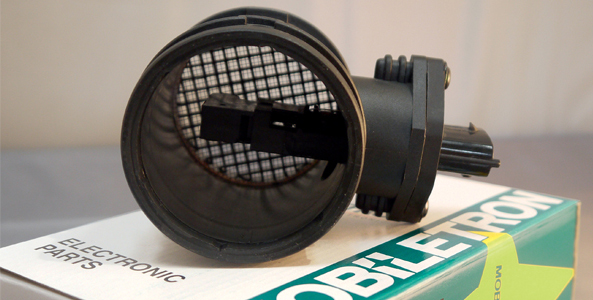

MAF sensors
MAF sensors can produce driveability symptoms without generating an engine management warning light.
Typical symptoms
■ A no start condition
■ Extended crank time when engine is cold
■ Stalls at idle, surging idle
■ Hesitation
■ Poor driving behaviour, power loss under maximum acceleration
■ Decreased fuel economy
■ Incorrect gear selection (automatics only).
Typical causes of failure
■ Poor contact in wiring/connector
■ Contamination by foreign substance
■ Sensor filament performance deterioration over time, causing incorrect readings.
Basic testing
■ Check condition of vehicle wiring harness and if output voltage is correct
■ Use scan tool to read fault code (if there is one) and monitor sensor readings to see if reading increases/decreases steadily proportional to RPM change (alternatively use an oscilloscope if scan tools are not available or cannot be used to read sensor output values – this is in fact a more accurate method).

Lambda sensors
Lambda sensors measure the oxygen level in the exhaust system. The ECU then uses the information to adjust and balance the fuel mixture in order to achieve the ideal air-fuel ratio, which in return would maximise fuel economy and minimise emissions.
Typical symptoms
■ Drivability issues
■ Poor fuel economy
■ High CO and HC emissions, resulting in MOT failure.
Typical causes of failure
■ Sensor contamination by lead from leaded petrol or Silicon from anti-freeze, or from carbon build up over time affecting sensitivity of sensor
■ Heater element failure, resulting in rich fuel mixture at idle.
Basic testing
■ Contamination can be spotted by visual inspection, i.e shiny deposits implies a high level of lead in fuel
■ Heater filament damage can be easily tested by measuring the heater resistance using an ohmmeter and comparing against manufacturer data – complete failure usually results in an open circuit
■ A functionality test can be performed on the vehicle by monitoring output voltage using an oscilloscope or voltmeter. Check against varying engine load – the response should be instantaneous and fluctuate between 0.2 and 0.8 volts for Zirconia sensors and between 2 and 5 volts for Titania sensors.
■ Lambda sensors can sometimes produce faulty readings due to an air leak in the intake or exhaust manifold or even a faulty spark plug. These should be the areas you look at if replacing the Lambda sensor failed to cure the problem.









